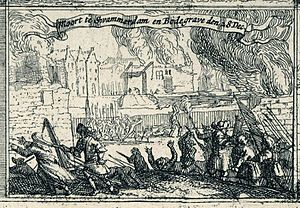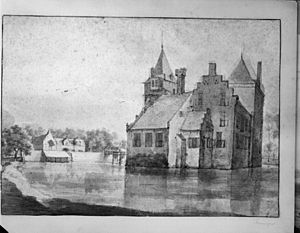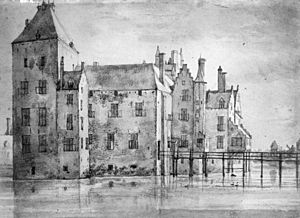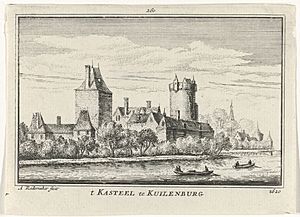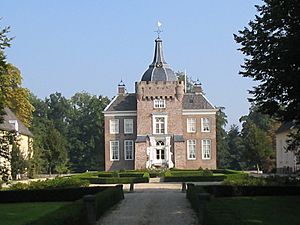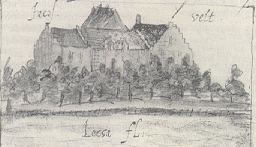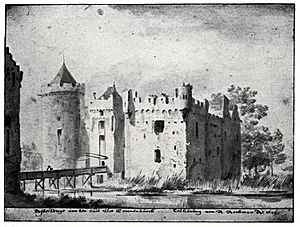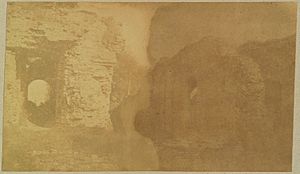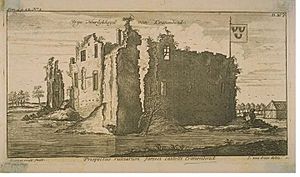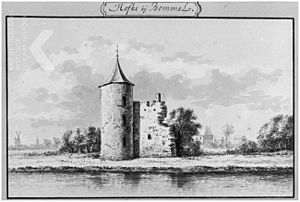List of areas in the Dutch Republic destroyed or damaged during the Franco-Dutch War facts for kids
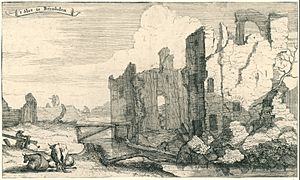
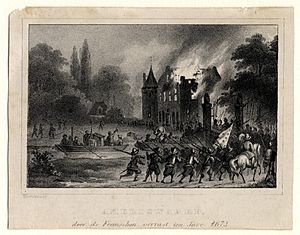
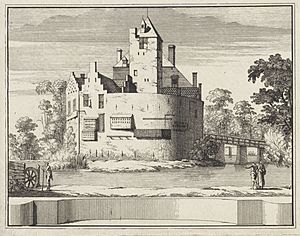
Imagine a time when a whole country faced a huge disaster! This happened in the Dutch Republic in 1672, a year known as the Rampjaar (Disaster Year). During the Franco-Dutch War, French troops, led by King Louis XIV, caused a lot of damage. Their plan was to "burn as much as possible" and "burn down entire villages."
This article lists many villages, country houses, and castles that were destroyed or badly damaged by the French in 1672 and 1673. Some of these places completely disappeared. Others are now ruins or were rebuilt later. It's important to know that Valkenburg Castle was an exception. It was destroyed by the Dutch leader, William III of England, not the French. He blew it up to stop the French from using it again.
Contents
Villages Attacked by French Troops
In 1672 and 1673, French soldiers didn't just attack castles. They also damaged and destroyed many villages. An artist named Isaac Sorious even made etchings (a type of print) showing this destruction.
- Abcoude was burned on November 6, 1672.
- Breukelen was destroyed in 1672.
- Bodegraven was completely flattened, and many people lost their lives.
- Harmelen: The church here was destroyed in 1672.
- Naarden
- Nigtevecht, also called Nichtevecht, was almost completely destroyed on April 21, 1673. Only a small part of the church tower and the schoolmaster's house remained.
- Overmeer near Nederhorst den Berg was also destroyed.
- Vreeswijk was damaged twice in October 1672, and its church was destroyed.
- Waverveen was destroyed.
- IJsselstein was partly burned by the French in 1672.
- Zwammerdam was totally destroyed, and many people were killed.
Country Houses and Castles Damaged or Destroyed
Here's a list of country houses and castles that were damaged or destroyed by French troops in 1672-1673. They are listed in alphabetical order by their Dutch municipality (local area).
A
- Amerongen
- Amerongen Castle, Kasteel Amerongen: In February 1673, French troops set this castle on fire. It burned for two days.
- Appeltern (w:nl:Huis Appeltern in Dutch) was mostly destroyed in 1672 but was rebuilt later.
- Asperen: Wadestein was destroyed by French troops in 1672.
B
- Baambrugge: Valckenheining on Angstel River. The French destroyed at least one building belonging to the Valckenier family in 1672.
- Balgoij: Huis Balgoij, in Wijchen. French troops destroyed this house in 1672.
- Brakel: w:nl:Kasteel Brakel (in Dutch) was blown up on September 11, 1672, by French troops. It was never rebuilt and remains a ruin.
- Breukelen
- Aastein was destroyed by the French in 1672.
- Gunterstein Castle, Slot te Breukelen, was burned and blown up on September 12, 1673.
- w:nl:Kasteel Nijenrode (in Dutch), Huis Nyenrode, was largely destroyed on September 6 and 7, 1673. The French army used it as their headquarters.
- w:nl:Queekhoven (in Dutch) was destroyed in 1672 and later rebuilt.
- w:nl:Kasteel Ruwiel (in Dutch), Ruwiel Castle, was destroyed by French troops on July 21, 1673.
- Vecht en Dam was destroyed in 1672/1673.
- Vegtvliet or Vechtvliet was destroyed when the French left in 1673.
- Voortwijk was burned by the French in 1672.
- w:nl:Vreedenoord (in Dutch) or Vredenoord: A farmhouse here was set on fire in 1672.
- Bunnik:
- w:nl:Nieuw-Amelisweerd (in Dutch) was destroyed.
- w:nl:Oud-Amelisweerd (in Dutch) was largely destroyed in 1672 but was rebuilt in 1770.
C
- Culemborg: Culemborg Castle w:nl:Kasteel Culemborg (in Dutch) was severely damaged in 1672/1673 by French troops.
D
- De Steeg, municipality Rheden: The main castle Middachten Castle was badly damaged by French troops in 1672.
E
- Epe: Quickborn, also Domselaar or Huis te Epe, was severely damaged by French troops.
G
- 's-Graveland: De Hooge Dreuvik and Rontomwelgevallen, country houses of Admiral Cornelis Tromp. He later built a new house nearby.
H
- Haaften: w:nl:Kasteel Goudenstein (in Dutch) was destroyed by French troops in 1672, leaving only a tower.
- Haarzuilens: De Haar Castle was partly destroyed in 1672 by the French.
- Harmelen: Huis Harmelen was destroyed in 1672.
- Heukelum: Merckenburg Castle was blown up by the French in 1672.
- Herwijnen: Huis te Herwijnen was destroyed or badly damaged by the French in 1672.
- Hoevelaken: The fortress Huis te Hoevelaken was destroyed by fire in 1672.
J
- Jaarsveld: Castle Slot te Jaarsveld, w:nl:Kasteel Veldenstein (in Dutch), Kasteel Jaarsveld. French troops set fire to this castle in 1673, and it was never rebuilt.
L
- Lobith: w:nl:Tolhuis (Lobith) (in Dutch). French troops damaged the large tower of this toll castle in 1672.
- Loenen aan de Vecht
- Former Castle Kronenburg (in Dutch) or Cronenburg(h): It was occupied by the French. In September 1673, its main tower was blown up.
- Nieuwerhoek was heavily damaged during the French attack on Kronenburg.
- Lopik: Huis te Jaarsveld or Veldenstein was looted and set on fire by French troops in 1673.
M
- Maarheeze: Castle Cranendonck, w:nl:Kasteel Cranendonck (in Dutch), is now a ruin. It was destroyed by French troops in 1673.
- Maarssen
- w:nl:Cromwijck (in Dutch)
- w:nl:Huis ten Bosch (Maarssen) (in Dutch) was destroyed and later rebuilt.
- Ridderhofstad Ter Meer (in Dutch), also known as Slot te Maarssen: It was looted on December 12, 1672, and completely burned. It was rebuilt in 1710.
- Maasbommel: Bommel Castle, Kasteel Bommel, was burned by French troops in 1674, leaving a ruin. The damage was huge, including furniture, sheds, and even farm animals.
- Maasdriel: w:nl:Slot van Well (nl) was badly damaged in 1672 by French troops.
- Millingerwaard: Millingen was destroyed in 1672 by French troops.
- Montfoort: w:nl:Kasteel Montfoort (in Dutch), Montfoort Castle. French troops destroyed the main castle in 1672. The tower was blown up when they left.
N
- Nederhorst den Berg: w:nl:Kasteel Nederhorst (in Dutch) was set on fire by French troops in 1672.
- Nieuwegein: w:nl:Kasteel Rijnhuizen (in Dutch) was destroyed by the French in 1672.
- Nieuwersluis: Weeresteyn was built around 1700 where an older fortified house was likely destroyed by the French in 1672–1673.
O
- Overasselt:
- Nagelhorst was mostly destroyed in 1672.
- Overasselt: This "noble house" was set on fire by the French on May 1, 1672, and probably never rebuilt.
P
- Poederoijen: w:nl:Kasteel Poederoijen (nl) was definitely destroyed by French troops in 1672.
- Putten: w:nl:Kasteel Oldenaller (nl) or Oudenaller was occupied and destroyed by French troops.
V
- Vuren: "Thuys te Vuyren" (House at Vuyren) was destroyed by French troops in 1672.
W
- Wageningen: w:nl:Kasteel van Wageningen, Wageningen Castle. French troops probably destroyed most of this castle in 1672.
Unknown Locations
- Country house of the Lord van de Weert.
- Country house Huis Kroonwyck of Mr. Pauw.
Saved Country Estates and Fortresses
Not all places were destroyed! Some country estates, castles, and even fortresses were saved from the French in 1672.
- Abcoude: w:nl:Slot Abcoude (in Dutch) was saved because its defenders fought very bravely.
- Brakel: Kasteel Zuilichem (in Dutch) was saved thanks to the good connections the Huygens family had with the French court.
- Breukelen: w:nl:Ridderhofstad Oudaan or Oudaen was spared because its owners, the van der Burch family, were Catholic. The French general himself even stayed there.
- Doorwerth: Kasteel Doorwerth was saved.
- Herwijnen: w:nl:Kasteel Engelenburg (in Dutch) was saved.
- Kleve: Schenkenschanz was taken without a fight and not destroyed.
- Laag-Keppel: w:nl:Kasteel Keppel (in Dutch) was used as King Louis XIV's headquarters in 1672.
- Leersum: w:nl:Huis Zuylenstein (in Dutch), also Zuylestein, was saved because William III of England stepped in. This castle was only destroyed much later, during World War II.
- Linschoten: Castle w:nl:Te Nesse (in Dutch) was looted but not destroyed.
- Loenersloot: w:nl:Kasteel Loenersloot (in Dutch) was occupied by the French but not destroyed.
- Maarssen: The country house H(a)erteveld was saved in 1672/1673.
- Nijmegen: Fortress w:nl:Knodsenburg (in Dutch) near Nijmegen was occupied by the French but not destroyed.
- Oud-Zuilen: Zuylen Castle was not destroyed because its owners, the Van Tuyll van Serooskerken family, had good relations with the French.
- Voorst: w:nl:Kasteel Nijenbeek (in Dutch). In 1673, the owner received special protection from the French general.
- Wijk bij Duurstede: w:nl:Kasteel Duurstede, Duurstede Castle, was saved during the French occupation. The French commander thought it belonged to the friendly mayor of the town.
Images for kids


